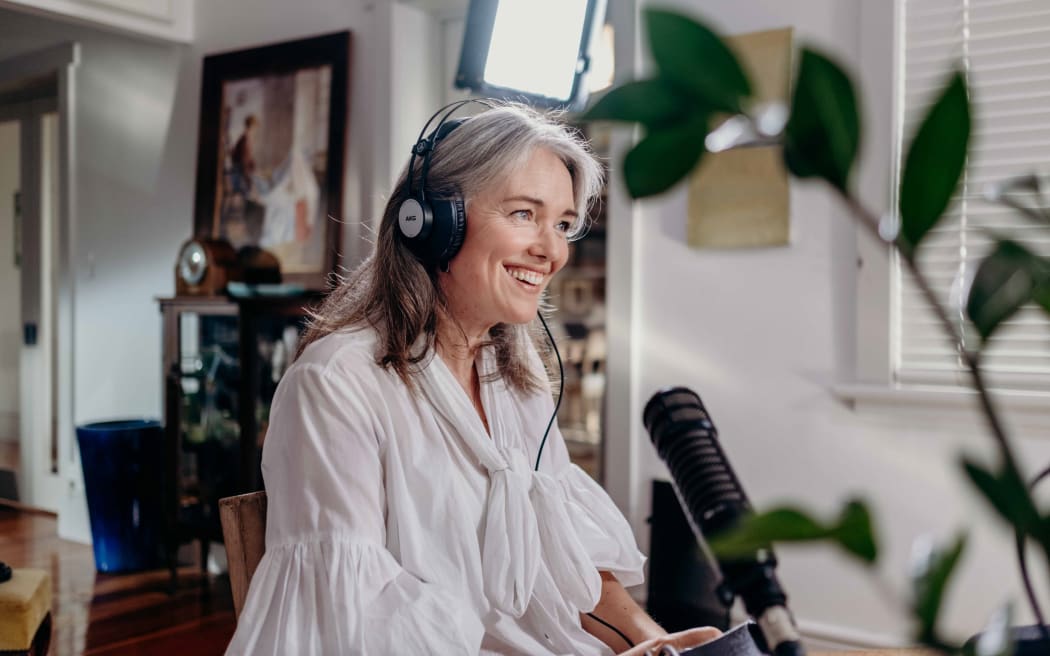Is there a new acceptance, and even celebration, of female aging, or has the mega-billion dollar beauty industry just latched onto a new way of parting women from their money?
Petra Bagust hosts her own podcast, ‘Grey Areas’, discussing growing up and going grey in Aotearoa.
Photo: Supplied
It’s being called a revolution, the “new black”, a new age of aging, where more and more older women are becoming comfortable in their own sagging skin.
The message is spreading that grey hair and wrinkles should be celebrated, despite the youth-obsessed fashion and beauty industry.
Even ex-Baywatch star Pamela Anderson is on board at the age of 56, appearing at Fashion Week makeup-free. And just last week Vogue featured 88-year-old actor Maggie Smith at the centre of fashion label Loewe’s new campaign.
Anderson said it gave her freedom, the very word used by Petra Bagust, long-time TV front person and now presenter of Grey Areas, a podcast for women about the challenges of aging.
Today The Detail talks to Bagust and Wendyl Nissen, the former women’s magazine editor known for embracing aging. Both have taken the plunge and ditched the dye, and both have resisted facial injectables like Botox.
Sharon and Petra.
Photo: Sharon Brettkelly
When Bagust decided to go grey in August 2018, she was not only thinking about her looks and how she felt about them, she was making a big career decision.
She was sick of the emotional rollercoaster of the monthly hair dye, feeling good in the first two weeks then distress at the sight of greys.
It sounds drastic and silly, she says, but our hair is a statement about ourselves.
“I was like, ‘what will I do?’ Because if I let my hair go grey, that’s it, I’m saying I’ll never be on telly again,” she says. “Generally speaking there haven’t been grey-haired women on telly and I decided I would set myself free.”
Wrinkles, she says, are a different story. She had tried Botox when she presented on TVNZ’s Breakfast and didn’t like it, but she had a “negative relationship” with her wrinkles until a friend told her she loved her laughter lines.
Bagust says she doesn’t know what opportunities she’s missed since she quit as a blonde, but the change has opened up new opportunities, including the podcast series which has a mission to “carve out a sanctuary for women in this age bracket, to help them realise they are not alone”.
Author, broadcaster and former Woman’s Weekly editor Wendyl Nissen says TV shows and films are increasingly featuring older women, wrinkles and all.
She’s just interviewed 58-year-old New Zealand actor Robyn Malcolm who has done two shows where “she really looks her age”, including ‘After The Party’ where she is nude as a life drawing model.
Wendyl Nissen.
Photo: Jane Ussher
“That is what we need. We need to watch these women and have a relevance. But she had to fight hard to get that.”
Nissen says changing attitudes mean women have the freedom to be themselves and don’t feel they have to hide away.
But the new era of embracing the natural look appears to have no impact on the beauty industry which is projected to grow in value to nearly US$600 billion by 2027, according to consultants McKinsey & Company.
Nissen, who admits to having spent an “inordinately huge amount” on her new makeup kit, says beauty companies are fully aware of the value of a growing senior population and are targeting them with products and campaigns featuring older women.
Celebrating age has not stopped the “cynical manipulation of women for money”, she says.
Nissen explains to The Detail how magazines are using social media to test the appetite of the market for featuring older women on their covers and in their stories.
“They’re not going to do it unless it works and I think we’ll see more of that. We used to do what we called experimental covers where you’d take a risk and just see if it sold. Because there’s a lot of us – there’s a lot of women in this age group and we do have money and we do support magazines and we love a magazine, we still like some print. I think it’s great.”
Check out how to listen to and follow The Detail here.
You can also stay up-to-date by liking us on Facebook or following us on Twitter.
Photo:
